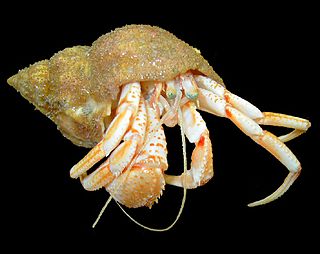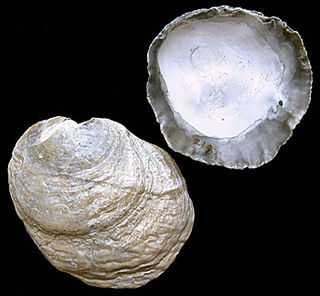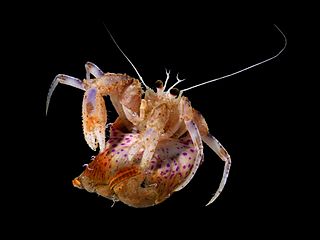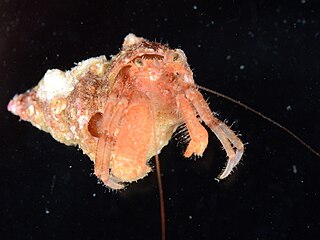
Hermit crabs are anomuran decapod crustaceans of the superfamily Paguroidea that have adapted to occupy empty scavenged mollusc shells to protect their fragile exoskeletons. There are over 800 species of hermit crab, most of which possess an asymmetric abdomen concealed by a snug-fitting shell. Hermit crabs' non-calcified abdominal exoskeleton makes their exogenous shelter system obligatory. Hermit crabs must occupy shelter produced by other organisms, or risk being defenseless.

Nereis is a genus of polychaete worms in the family Nereididae. It comprises many species, most of which are marine. Nereis possess setae and parapodia for locomotion. They may have two types of setae, which are found on the parapodia. Acicular setae provide support. Locomotor setae are for crawling, and are the bristles that are visible on the exterior of the Polychaeta. They are cylindrical in shape, found not only in sandy areas, and they are adapted to burrow. They often cling to seagrass (posidonia) or other grass on rocks and sometimes gather in large groups. They are dangerous to touch giving very painful long lasting burns. Nereis worms are commonly known as rag worms or clam worms. The body is long, slender, and dorso-ventrally flattened, reaching a length of 5-30 cm. The head consists of two parts: a roughly triangular anterior lobe—the prostomium—and a posterior ring-like portion—the peristomium. The latter bears a pair of terminal tentacles, dorsally two pairs of eyes, and ventrally a pair of short two-jointed palps.

Pagurus bernhardus is the common marine hermit crab of Europe's Atlantic coasts. It is sometimes referred to as the common hermit crab or soldier crab. Its carapace reaches 3.5 centimetres (1.4 in) long, and is found in both rocky and sandy areas, from the Arctic waters of Iceland, Svalbard and Russia as far south as southern Portugal, but its range does not extend as far as the Mediterranean Sea. It can be found in pools on the upper shore and at the mean tide level down to a depth of approximately 140 metres (460 ft), with smaller specimens generally found in rock pools around the middle shore and lower shore regions, with larger individuals at depth. P. bernhardus is an omnivorous detritivore that opportunistically scavenges for carrion, and which can also filter feed when necessary.

Nereididae are a family of polychaete worms. It contains about 500 – mostly marine – species grouped into 42 genera. They may be commonly called ragworms or clam worms.

Pagurus armatus, the armed hermit crab or black-eyed hermit crab, is a species of hermit crab found in the eastern Pacific Ocean of the United States and British Columbia, Canada.

Alitta succinea is a species of marine annelid in the family Nereididae. It has been recorded throughout the North West Atlantic, as well as in the Gulf of Maine and South Africa.

Calliactis parasitica is a species of sea anemone associated with hermit crabs. It lives in the eastern Atlantic Ocean and Mediterranean Sea at depths between the intertidal zone and 60 m (200 ft). It is up to 10 cm × 8 cm in size, with up to 700 tentacles, and is very variable in colour. The relationship between C. parasitica and the hermit crab is mutualistic: the sea anemone protects the hermit crab with its stings, and benefits from the food thrown up by the hermit crab's movements.

Novocrania anomala is a species of brachiopod found offshore in the eastern Atlantic Ocean.

Pododesmus patelliformis, the ribbed saddle-oyster, is a species of bivalve mollusc in the family Anomiidae. It is found in the north east Atlantic Ocean.

Pagurus prideaux is a species of hermit crab in the family Paguridae. It is found in shallow waters off the northwest coast of Europe and usually lives symbiotically with the sea anemone Adamsia palliata.
Haplosyllis spongicola, the sponge worm, is a species of polychaete worm in the family Syllidae. It was previously classified as Syllis spongicola and is part of a species complex of closely related species that are difficult to distinguish morphologically and where the demarcation between them is unclear. It is found in shallow temperate, subtropical and tropical seas worldwide, wherever its host sponges are found.
Odontosyllis phosphorea, commonly known as a fireworm, is a polychaete worm that inhabits the Pacific coast of North and Central America. The organism normally lives in a tube on the seabed, but it becomes bioluminescent when it rises to the surface of the sea during breeding season.

Phyllodocidae is a family of polychaete worms. Worms in this family live on the seabed and may burrow under the sediment.

Polydora ciliata is a species of annelid worm in the family Spionidae, commonly known as a bristleworm. It is a burrowing worm and is found in the northeastern Atlantic Ocean and some other parts of the world.
Pagurus forbesii is a species of hermit crab in the family Paguridae. It is found in the northeastern Atlantic Ocean and the Mediterranean Sea.
Dipolydora commensalis is a species of polychaete worm in the family Spionidae. It has a commensal relationship with a hermit crab and occurs on the lower shore of coasts on the western side of the Atlantic Ocean.
Polydora glycymerica is a species of annelid worm in the family Spionidae, native to the northwestern Pacific Ocean, where it lives commensally in association with a bivalve mollusc, usually Glycymeris yessoensis but occasionally with another species of clam. The worm intercepts food particles being drawn into the mollusc by its feeding current.

Pagurus dalli, commonly known as the whiteknee hermit, is a species of hermit crab in the family Paguridae. It is found in the northeastern Pacific Ocean at depths down to about 276 m (900 ft). It usually lives in a mutualistic symbiosis with a sponge, or sometimes a hydroid.

Clistosaccus is a genus of barnacles which are parasitic on hermit crabs. It is a monotypic genus, and the single species is Clistosaccus paguri, which is found in the northern Atlantic Ocean and the northern Pacific Ocean.

Neanthes arenaceodentata is a species of marine polychaete worm in the family Nereididae. It occurs in shallow waters in the tropical Atlantic and Pacific Oceans. It has been used in the laboratory in testing the toxicity of marine sediments.













